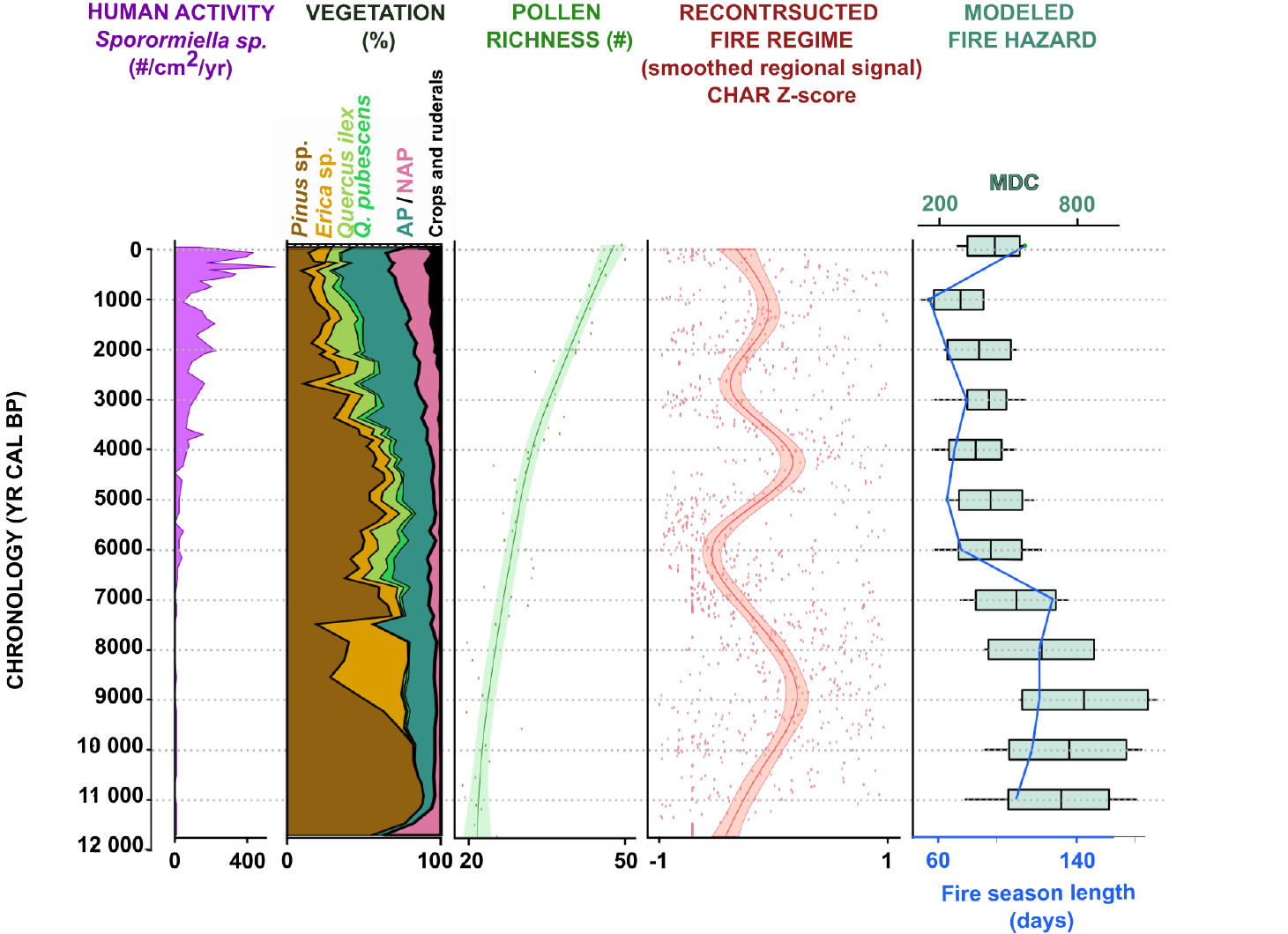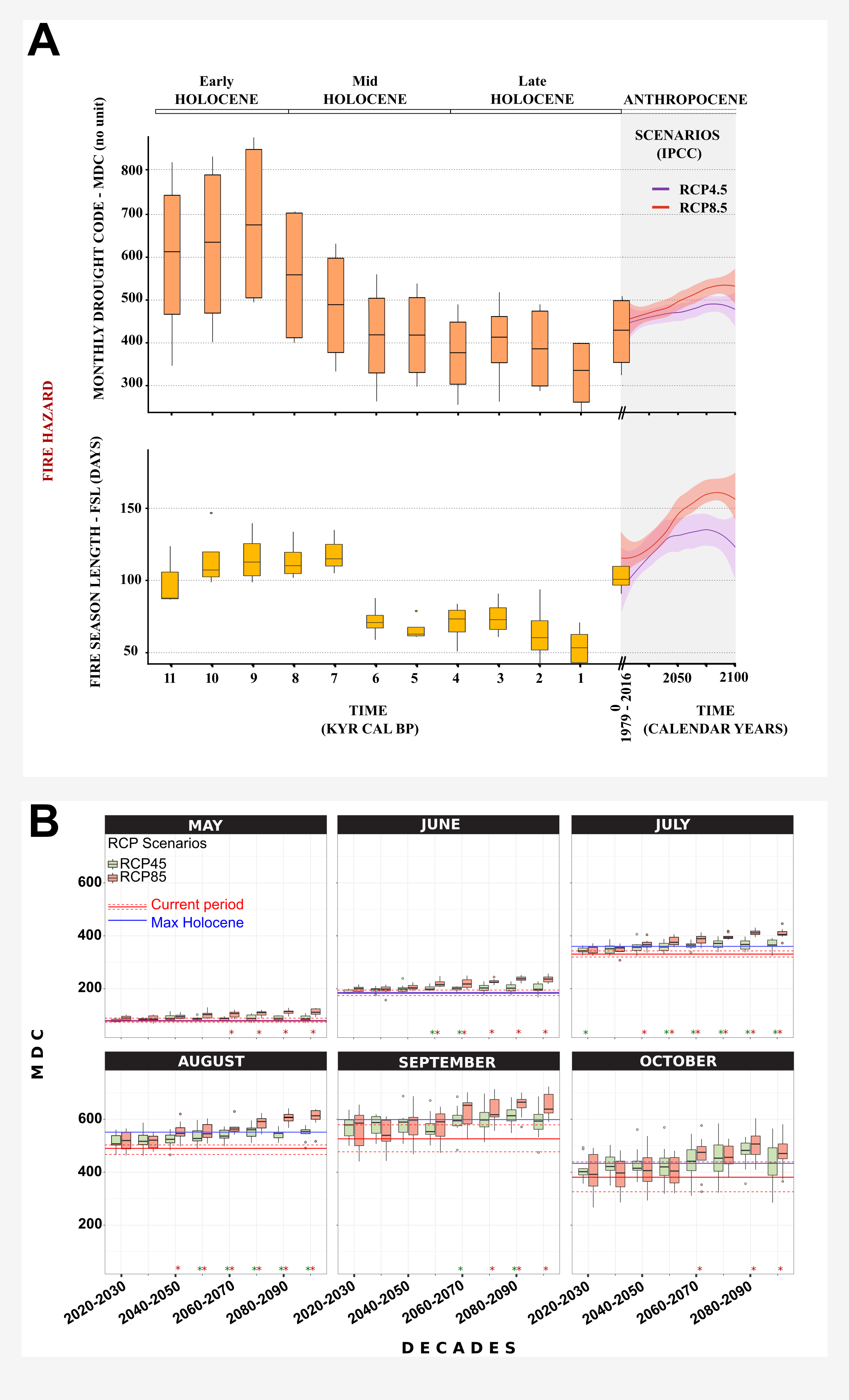- Home
- Publications
- PAGES Magazine
- Future Fire Predictions In Light of Millennial Fire Regime Variability In Corsica, France
Future fire predictions in light of millennial fire regime variability in Corsica, France
Lestienne M, Hély C, Jouffroy-Bapicot I, Curt T and Vannière B
Past Global Changes Magazine
30(1)
46-47
2022
Corsican biodiversity is threatened by both climate and disturbance-regime changes. Here, we simulate the future impacts of fires and discuss how integrated paleomodeling approaches can help assess future trends, in the context of the millennial-scale fire variability.
Over the past few decades, a surge in the number of large, uncontrolled wildfires has occurred worldwide, irrespective of national fire-fighting capacities or management policies. Global warming predicted by climate models for the next decades could further amplify this trend and threaten most ecosystems worldwide (e.g. Varela et al. 2019). In the Mediterranean basin, Corsica is a fire "hotspot" due to dry summers and traditional fire use (e.g. slash-and-burn practices). In the last five decades (1973–2019), 2369 large fires (> 10 ha) were recorded (promethee.com). This number could significantly increase in the future due to a combination of climatic changes and increases in human-caused ignition (Curt et al. 2016), with consequences on biodiversity, people, and infrastructure.
Corsican fire history
Fires have been frequent in Corsica for at least the last 11,500 years, with two main increases evidenced in paleoecological records (Fig. 1; Lestienne et al. 2020b).
The first increase between 11,500 and 7000 yr cal BP corresponded to the development of Pinus sp. forests during the Early Holocene, followed by shrubby ecosystems dominated by Erica sp. This ecosystem development increased the amount of fuel available near the ground and the connectivity between the ground and the tree tops, promoting crown fires (e.g. Curt et al. 2013). Independent proxy-based studies at the regional scale indicate that this period experienced hot and dry summer climates (e.g. Vannière et al. 2011), i.e. optimal conditions for wildfires to ignite and spread.
To model fire climate conditions, we used climate-model simulations and adapted two indices derived from the Fire Weather Index estimating the fire hazard (Van Wagner 1987): the Monthly Drought Code (MDC, calculated from air temperature and precipitation; Girardin et al. 2013) and the Fire Season Length (FSL in days; Hély et al. 2010), representing the number of days with MDC > 300 (Lestienne et al. 2020a). Before 7000 yr cal BP, high MDC and FSL values indicate summer droughts conducive to fire. Thus, a combination of climate conditions favorable to fire and fuel availability may explain the frequent fires during the Early Holocene.
The second fire period extended from 5000 yr cal BP to the present. It followed a two-millennia-long period without fire, during which evergreen (Q. ilex-type) and deciduous (Q. pubescens) oak forests expanded, due to superior competitiveness (Colombaroli et al. 2009). After 5000 yr cal BP, landscapes became more open, and fire frequency and pollen-inferred biodiversity increased with the development of crops and pastures (Fig. 1). During this period, the fire signal varied locally (Lestienne et al. 2020b), and lower modeled MDC and FSL values (wetter conditions) support the hypothesis of an anthropogenic cause for the observed fire regime.
Future predictions
When comparing the Holocene fire hazard indices (MDC and FSL) with the predicted indices for the next eight decades and for two RCP scenarios (4.5 and 8.5), both scenarios show an increase until 2100, with a stronger increase in fire from 2050 using the RCP8.5 scenario (Fig. 2a; Lestienne et al. 2022). The MDC may increase from 424 to 456 (7% increase) for the RCP4.5 scenario and from 429 to 519 (17% increase) for RCP8.5 between 2020 and 2100. Accordingly, a lengthening of the fire season may also be expected (by 25–45 days, i.e. between 19% and 28%). This range of future lengthening of the fire season is in line with the 30 days estimated using previous climate simulations and fire indices (e.g. Giannakopoulos et al. 2005), but so far no study has proposed a Holocene framework for estimating and quantifying the significance of these future changes. Lestienne et al. (2022) showed that during the Holocene, such values (MDC > 400 and FSL > 100 days) have not been reached since 6000 yr cal BP, and the future FSL may exceed the Holocene maximum as early as 2040, regardless of the RCP scenario (Fig. 2b).
Our results also show that this global increase will most likely not be the same for each month of the fire season (Fig. 2b; Lestienne et al. 2022): the MDC will reach its maximum during the summer months (June to August) with values higher than those observed during the Holocene maximum in both scenarios, and higher than historical means in the RCP8.5 scenario. The causes for this marked summer drying were investigated by Rowell and Jones (2006), who considered four possible mechanisms: (1) low soil-moisture conditions; (2) large land-sea contrast in warming conditions; (3) positive feedback from summer soil-moisture and precipitation; and (4) remote influences from teleconnections. These changes appear to be similar in both RCP scenarios until 2050 and will, therefore, depend on political and economic choices after 2050 (e.g. the use of green or fossil energy).
Our data suggest that the predicted increase in fire by 2050 will be significantly different from what Corsican ecosystems experienced during the Early Holocene, because other factors (including vegetation and human activities) also impact fire. Most studies agree that increasing drought will strongly contribute to increases in the frequency and intensity of forest fires in the Mediterranean, especially in southern France and Corsica (e.g. Mouillot et al. 2002). Our study complements these results by highlighting the increase in the duration of the fire season and intensification of the fire hazard.
A strong increase in fire occurrence, coupled with drier conditions, could lead to a significant decrease in plant biodiversity in Corsica (e.g. Lestienne et al. 2020b). Such ecological change would lead to significant economic losses (e.g. reduction in tourism). In France, the large fires in the 1990s led to the implementation of a very effective firefighting policy under weather conditions of the last decades (Curt and Frejaville 2018). However, this will likely be challenged by more extreme conditions in the coming years. Over the next 30 years, our current policies will also influence the climate response on longer timescales. Integrative studies combining modeling, long-term data records, and traditional fire knowledge can provide valuable insights to understand fire responses to complex vegetation–human–climate interactions, and support policy decisions in biodiversity hotspot regions such as Corsica.
affiliations
1Chrono-environnement, CNRS, Université Bourgogne Franche-Comté, Besançon, France
2ISEM, Université Montpellier, CNRS, EPHE, IRD, Montpellier, France
3Department of Forest Ecology, Faculty of Forestry and Wood Sciences, Czech University of Life Sciences Prague, Czech Republic
4EPHE, PSL University, Paris, France
5INRAE – RECOVER, Aix Marseille Univ, Aix-en-Provence, France
6MSHE Ledoux, CNRS, Université Bourgogne Franche-Comté, Besançon, France
contact
Marion Lestienne: lestienne fld.czu.cz
fld.czu.cz
references
Colombaroli D et al. (2009) J Biogeogr 36: 314-326
Curt T, Frejaville T (2018) Risk Anal 38: 472-488
Curt T et al. (2013) J Environ Manag 117: 150-161
Curt T et al. (2016) Int J Wildland Fire 25: 785-796
Girardin MP et al. (2013) For Ecol Manage 294: 238-249
Hély C et al. (2010) Geophys Res Lett 37: L14709
Lestienne M et al. (2020a) Fire 3: 8
Lestienne M et al. (2020b) Holocene 30: 244-257
Lestienne M et al. (2022) Clim Change 170: 14
Mouillot F et al. (2002) Glob Chang Biol 8: 423-437
Rowell DP, Jones RG (2006) Clim Dyn 27: 281-299


